
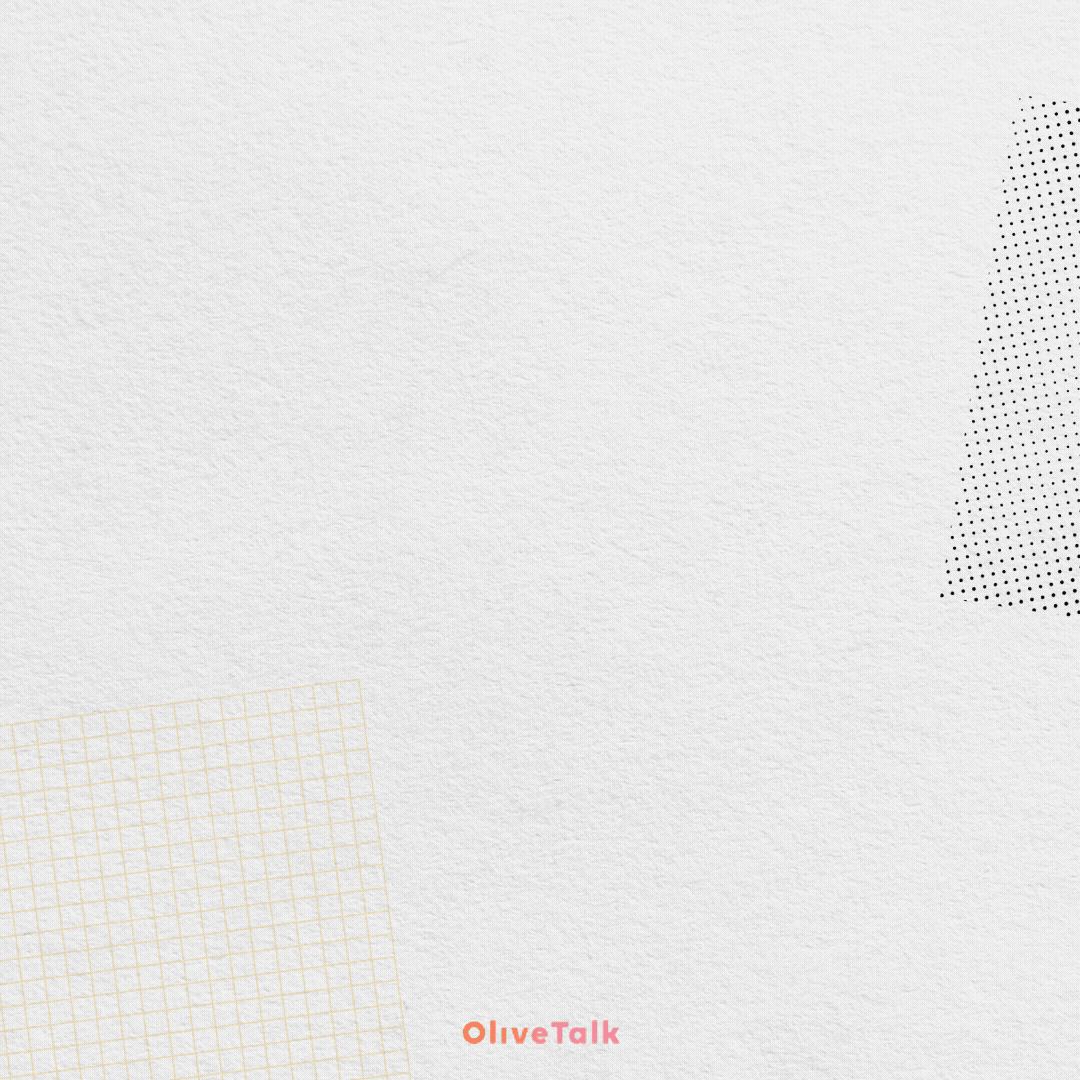
🌿 What Is Lactobacillus Ferment Lysate (Probiotic Ferments)?
Lactobacillus ferment lysate is a postbiotic a non‑viable extract derived from the fermentation of Lactobacillus probiotics. In topical skincare, it’s prized for its soothing, anti-inflammatory, barrier-strengthening, and microbiome-supporting benefits.
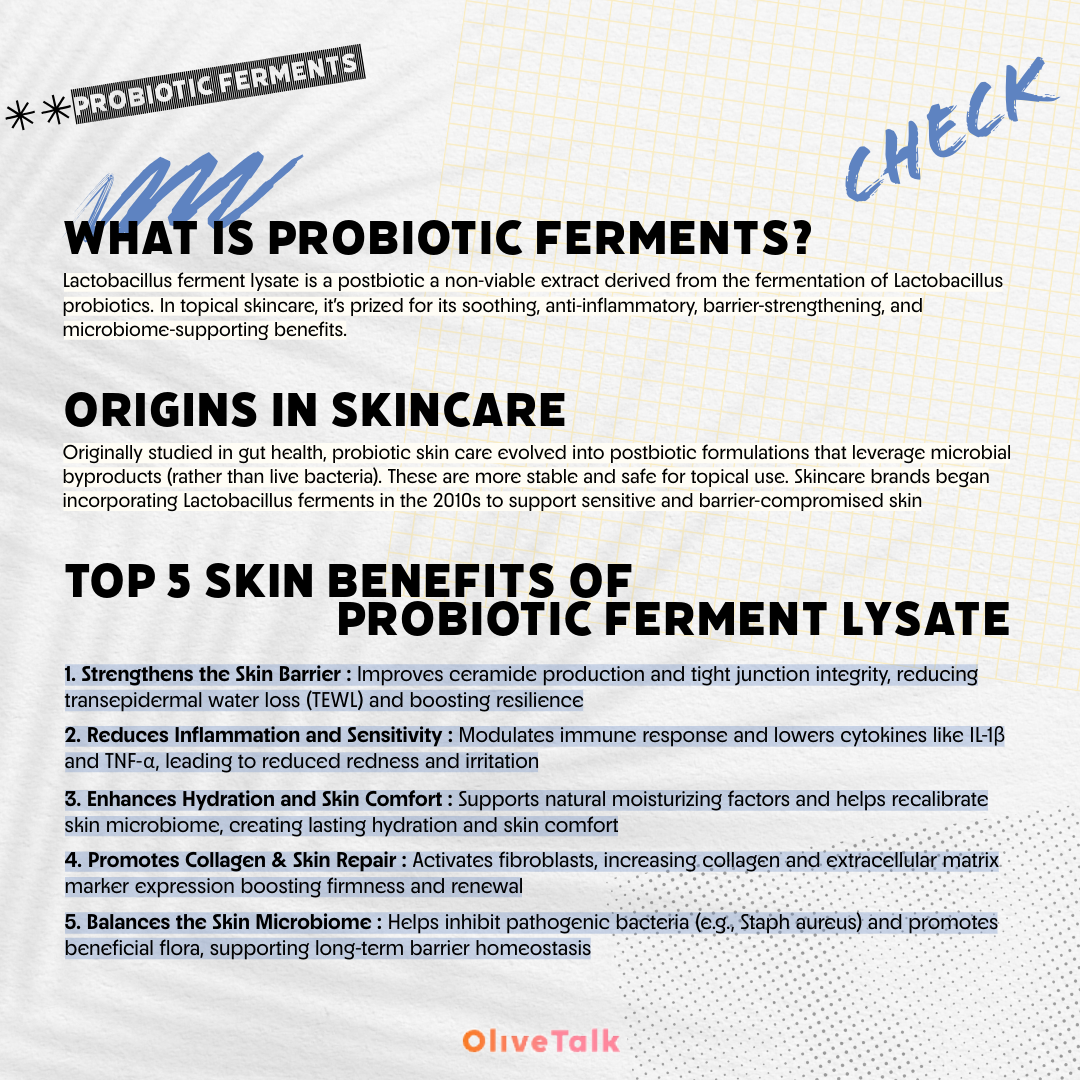
🏺Origins in Skincare
Originally studied in gut health, probiotic skin care evolved into postbiotic formulations that leverage microbial byproducts (rather than live bacteria). These are more stable and safe for topical use. Skincare brands began incorporating Lactobacillus ferments in the 2010s to support sensitive and barrier‑compromised skin.
Top 5 Skin Benefits of Probiotic (Lactobacillus) Ferment Lysate
🛡️ Strengthens the Skin Barrier
Improves ceramide production and tight junction integrity, reducing transepidermal water loss (TEWL) and boosting resilience
🔥 Reduces Inflammation and Sensitivity
Modulates immune response and lowers cytokines like IL‑1β and TNF‑α, leading to reduced redness and irritation
💧 Enhances Hydration and Skin Comfort
Supports natural moisturizing factors and helps recalibrate skin microbiome, creating lasting hydration and skin comfort
⏫ Promotes Collagen & Skin Repair
Activates fibroblasts, increasing collagen and extracellular matrix marker expression—boosting firmness and renewal
🦠Balances the Skin Microbiome
Helps inhibit pathogenic bacteria (e.g., Staph aureus) and promotes beneficial flora, supporting long-term barrier homeostasis
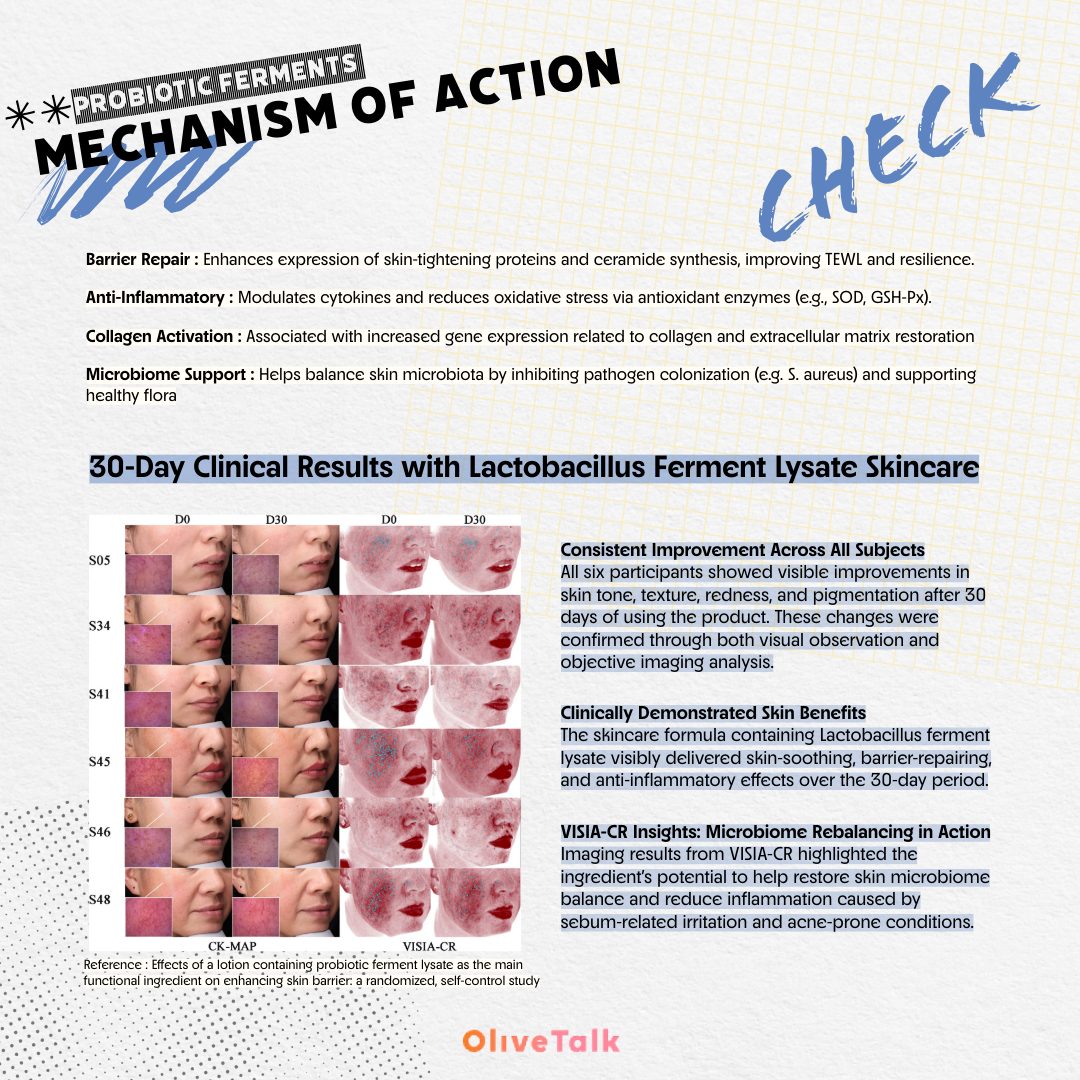
🔬 Mechanism of Action
- Barrier Repair: Enhances expression of skin‑tightening proteins and ceramide synthesis, improving TEWL and resilience.
- Anti‑Inflammatory: Modulates cytokines and reduces oxidative stress via antioxidant enzymes (e.g., SOD, GSH‑Px).
- Collagen Activation: Associated with increased gene expression related to collagen and extracellular matrix restoration.
-Microbiome Support: Helps balance skin microbiota by inhibiting pathogen colonization (e.g. S. aureus) and supporting healthy flora.
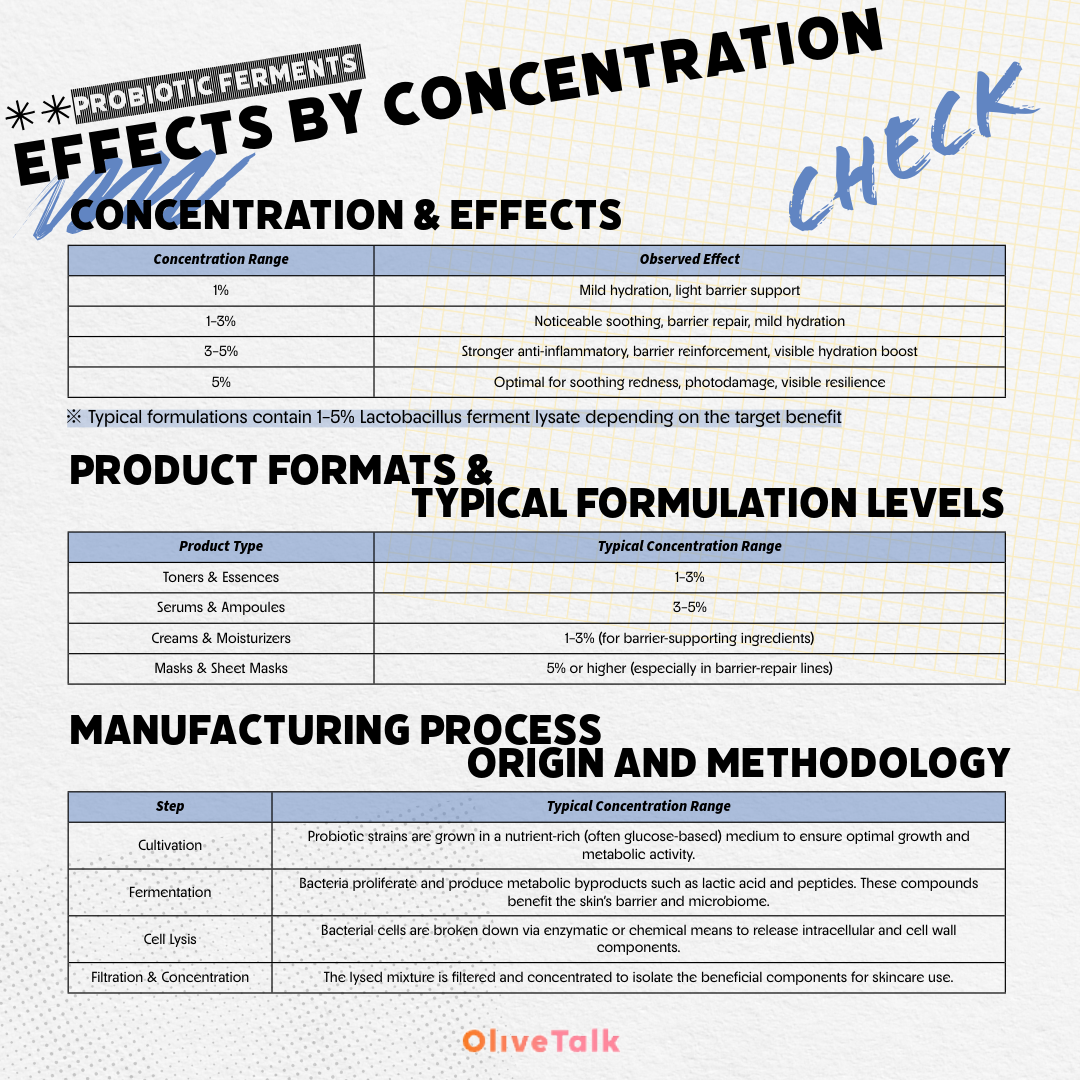
Concentration & Effects
(Concentration Range / Observed Effect)
1% / Mild hydration, light barrier support
1–3% / Noticeable soothing, barrier repair, mild hydration
3–5% / Stronger anti-inflammatory, barrier reinforcement, visible hydration boost
5% / Optimal for soothing redness, photodamage, visible resilience
※Typical formulations contain 1–5% Lactobacillus ferment lysate depending on the target benefit.
Product Formats & Typical Formulation Levels
Toners & Essences / Usually contain 1–3%
Serums & Ampoules / Often fall in the 3–5% range
Creams & Moisturizers / Most products use 1–3% as a barrier support component
Masks & Sheet Masks / Can reach 5% or higher, especially in barrier-repair lines
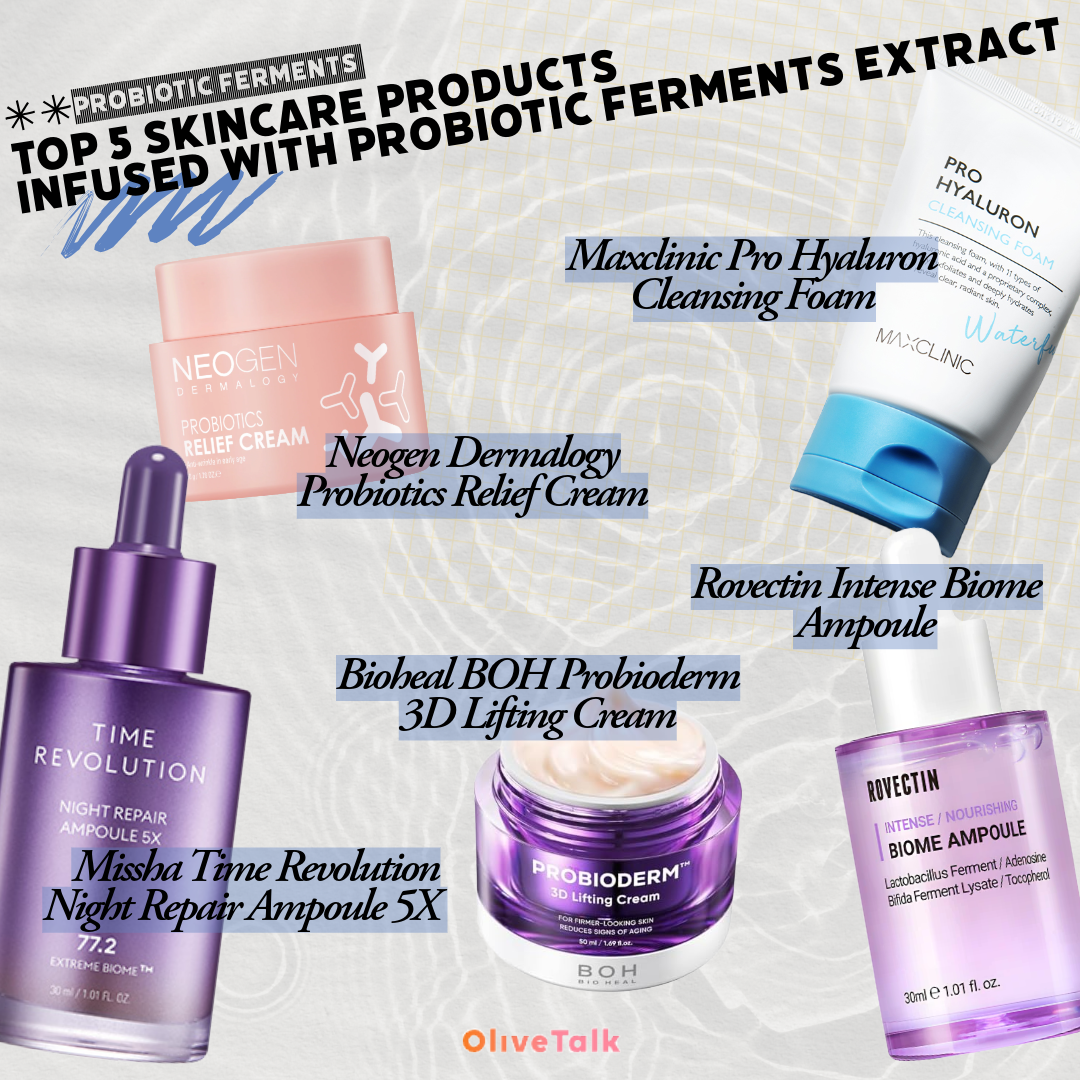
<Top 5 Skincare Products Infused with Probiotic Ferments Extract>
1. Rovectin Intense Biome Ampoule
Content : no information
Country : KR
2. Missha Time Revolution Night Repair Ampoule 5X
Content : no information
Country : KR
3. Bioheal BOH Probioderm 3D Lifting Cream
Content : no information
Country : KR
4. Neogen Dermalogy Probiotics Relief Cream
Content : no information
Country : KR
5. Maxclinic Pro Hyaluron Cleansing Foam
Content : no information
Country : KR
Clinical Evidence & Visual Summary
Lotion with Probiotic Ferment Lysate (human RCT) : Showed improved barrier recovery and skin resilience after topical use.
Mineral 89 Probiotic Complex Trial (38 women) : Combined with tretinoin, achieved reduced irritation, improved hydration, and better quality of life.
Postbiotic Review in Nutrients 2024 : Documents 14 clinical studies showing topical postbiotics (including Lactobacillus lysate) support hydration, reduce inflammation, and deliver antioxidant effects in healthy skin.
Past vs. Present
Previously : Probiotics were live organism–based supplements or specially preserved cosmetics, often unstable on the skin.
Today : Ferment lysates and postbiotics are preferred—much more stable, no need for live cultures, and compatible with sensitive or immunocompromised skin. The technology is validated via metabolome and peptide profiling.
Expert Tips for Use
Patch test: Though non‑viable, individuals with highly reactive skin should test first.
Use in Step after toner: Lightweight serums or essences work best.
Pair with ceramides, niacinamide: To maximize barrier and hydration synergy.
Avoid over-acidification: Strong acids may destabilize postbiotic peptides.
Expect results in ~4 weeks: Hydration, redness reduction, and texture improvements become visible with consistent use.
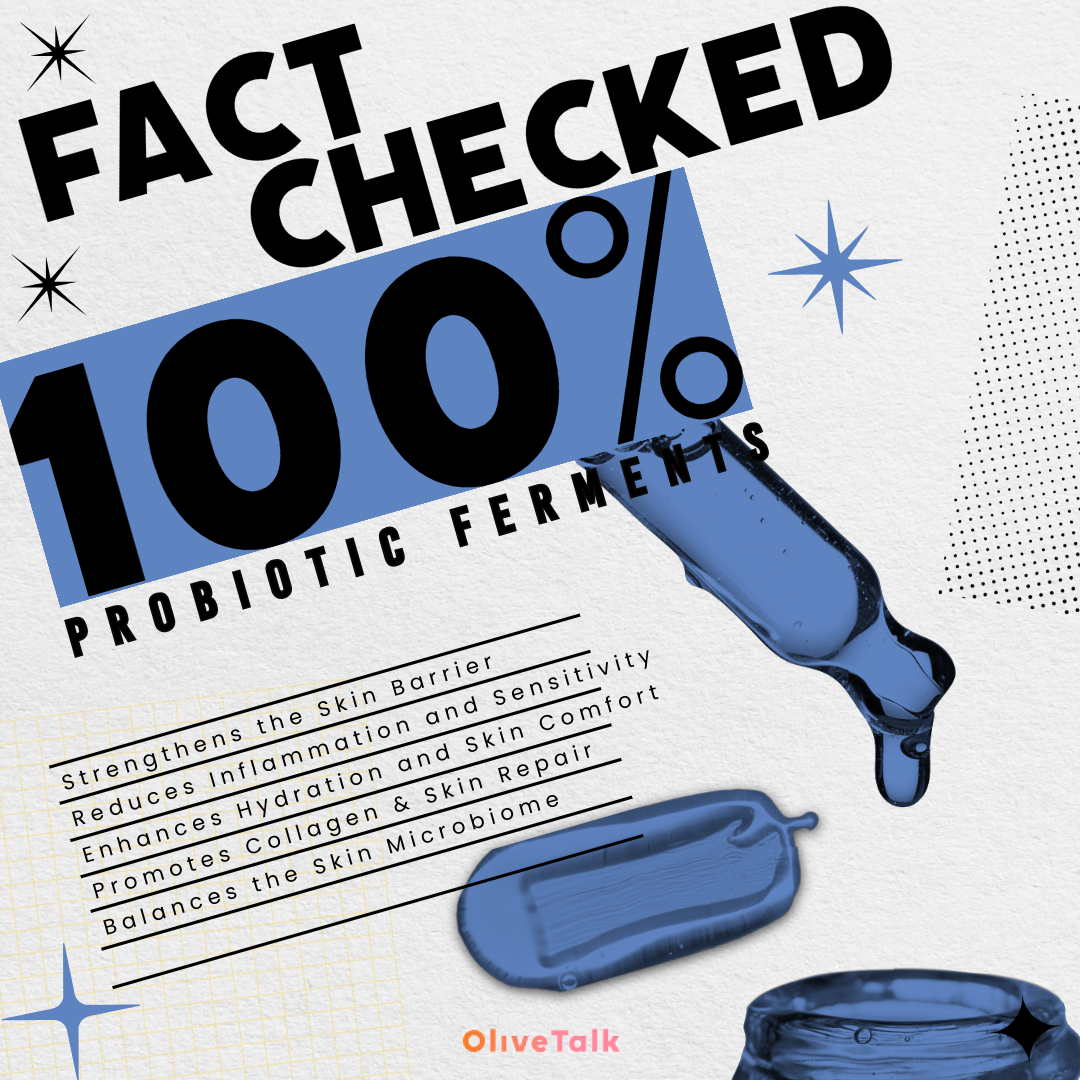
📚 References
Effects of a lotion containing probiotic ferment lysate on facial skin barrier—human clinical data.
Mineral 89 Probiotic Study with tretinoin users.
Nutrients 2024 review: Clinical trials of specific probiotic/postbiotic strains in cosmetics.
Paula’s Choice ingredient breakdown for Lactobacillus ferment lysate.
City Skin Clinic summary of probiotic skincare benefits.
Postbiotics in skin health—mechanistic overview (MDPI encyclopedia).
Reddit consumer review (Neogen prod usage with L. ferment lysate).
Allure overview on fermented skincare trend and microbiome context.
Byrdie overview of skin‑gut axis and topical skin probiotics relevance.
 72Comments
72Comments-
 FemaleSensitive25 days agoLove that this post actually breaks down the mechanisms and not just 'soothes skin' sentence
FemaleSensitive25 days agoLove that this post actually breaks down the mechanisms and not just 'soothes skin' sentence -
 FemaleSensitive25 days agoDidn't know postbiotics were different from probiotics till now 😯
FemaleSensitive25 days agoDidn't know postbiotics were different from probiotics till now 😯 -
 FemaleCombination25 days agoNeogen probiotics cream really helped with my winter redness
FemaleCombination25 days agoNeogen probiotics cream really helped with my winter redness FemaleOily25 days agoMe toooooo. Didn't expect much at first but it’s surprisingly calming
FemaleOily25 days agoMe toooooo. Didn't expect much at first but it’s surprisingly calming -
 FemaleCombination25 days agoProbiotic ferments r underrated fr. My barrier was wrecked after retinol and lactobacillus lysate literally saved my skin
FemaleCombination25 days agoProbiotic ferments r underrated fr. My barrier was wrecked after retinol and lactobacillus lysate literally saved my skin -
 FemaleOily25 days agoAnyone tried the missha one?? Heard it is a dupe for estee lauder anr but with probiotics
FemaleOily25 days agoAnyone tried the missha one?? Heard it is a dupe for estee lauder anr but with probiotics -
 FemaleSensitive25 days agoI'm kinda skeptical about prebiotic skincare but the postbiotics seems more convincing
FemaleSensitive25 days agoI'm kinda skeptical about prebiotic skincare but the postbiotics seems more convincing -
 FemaleSensitive25 days agoThis with niacinamide is my holy grail combo for post acne healing
FemaleSensitive25 days agoThis with niacinamide is my holy grail combo for post acne healing FemaleCombination25 days agoWhich niacinamide product did u use?
FemaleCombination25 days agoWhich niacinamide product did u use? FemaleSensitive25 days ago@Female/Combination I used theordinary niacinamide,zinc one
FemaleSensitive25 days ago@Female/Combination I used theordinary niacinamide,zinc one FemaleCombination25 days ago@Female/Sensitive Thx for the response 👍
FemaleCombination25 days ago@Female/Sensitive Thx for the response 👍 -
 FemaleOily25 days agoTried the rovectin one and it was a bit sticky but was great at calming down my eczema flare-ups
FemaleOily25 days agoTried the rovectin one and it was a bit sticky but was great at calming down my eczema flare-ups -
 FemaleOily25 days agoMy barrier says thank u
FemaleOily25 days agoMy barrier says thank u -
 FemaleSensitive25 days agoWhy does everything sounds like a science experiment lately lol
FemaleSensitive25 days agoWhy does everything sounds like a science experiment lately lol FemaleSensitive25 days agoFr 😂 I'm just here for the hydration. Science words r extra
FemaleSensitive25 days agoFr 😂 I'm just here for the hydration. Science words r extra -
 FemaleCombination25 days agoThat missha ampoule is SO underrated
FemaleCombination25 days agoThat missha ampoule is SO underrated -
 FemaleOily25 days agoThat's why some sheet masks with fermented ingredients feel way more hydrating
FemaleOily25 days agoThat's why some sheet masks with fermented ingredients feel way more hydrating -
 FemaleOily25 days agoPostbiotic skincare is not for an overnight but totally transforms ur skin in a long term
FemaleOily25 days agoPostbiotic skincare is not for an overnight but totally transforms ur skin in a long term -
 FemaleSensitive25 days agoCleansing foam with probiotics actually leaves my skin soft, not stripped
FemaleSensitive25 days agoCleansing foam with probiotics actually leaves my skin soft, not stripped FemaleSensitive25 days agoWhich product did u use??
FemaleSensitive25 days agoWhich product did u use?? FemaleSensitive25 days ago@Female/Sensitive The maxclinic one!
FemaleSensitive25 days ago@Female/Sensitive The maxclinic one! FemaleSensitive25 days ago@Female/Sensitive Got it 👍 ty!!
FemaleSensitive25 days ago@Female/Sensitive Got it 👍 ty!! -
 FemaleCombination24 days agoBeen using fermented skincare for a year now and my barrier is the strongest it has ever been
FemaleCombination24 days agoBeen using fermented skincare for a year now and my barrier is the strongest it has ever been -
 FemaleOily24 days agoPostbiotic is such a smart alternative. No need to stabilize live bacteria
FemaleOily24 days agoPostbiotic is such a smart alternative. No need to stabilize live bacteria -
 FemaleOily24 days agoDidnt know that it improves ceramide production. That explains why my skin felt more plump after using
FemaleOily24 days agoDidnt know that it improves ceramide production. That explains why my skin felt more plump after using -
 FemaleSensitive24 days agoThe fact that it reduces big inflammation markers is super interesting !!
FemaleSensitive24 days agoThe fact that it reduces big inflammation markers is super interesting !! -
 FemaleSensitive24 days agoBest ingredient for a long term improvement
FemaleSensitive24 days agoBest ingredient for a long term improvement -
 FemaleCombination24 days agoAnyone layered this under tretinoin? Wonder if it actually reduces peeling
FemaleCombination24 days agoAnyone layered this under tretinoin? Wonder if it actually reduces peeling -
 FemaleOily24 days agoWhy does no brand ever list actial conc of ferment lysate in products??????????
FemaleOily24 days agoWhy does no brand ever list actial conc of ferment lysate in products?????????? FemaleOily24 days agoFr TRANSPARENCY PLEASE
FemaleOily24 days agoFr TRANSPARENCY PLEASE FemaleSensitive24 days agoThat's bc they won't be able to overpriced products any longer then 😂😂
FemaleSensitive24 days agoThat's bc they won't be able to overpriced products any longer then 😂😂 -
 FemaleSensitive24 days agoI patch tested a probiotic essence and broke out 🥲 Could be another ingredient tho
FemaleSensitive24 days agoI patch tested a probiotic essence and broke out 🥲 Could be another ingredient tho -
 FemaleCombination24 days agoIve been layering a probiotic essence under my ceramide cream and my skin has been way less reactive
FemaleCombination24 days agoIve been layering a probiotic essence under my ceramide cream and my skin has been way less reactive -
 FemaleOily24 days agoIt works better on my skin when it is compromised or flaky
FemaleOily24 days agoIt works better on my skin when it is compromised or flaky -
 FemaleOily24 days agoI like that it doesnt overstimulate but just helps skin find its balance again
FemaleOily24 days agoI like that it doesnt overstimulate but just helps skin find its balance again FemaleSensitive24 days agoFr the best for skins that hate active routines
FemaleSensitive24 days agoFr the best for skins that hate active routines -
 FemaleSensitive24 days agoCan confirm that probiotic ferment and ceramides combo is the best for barrier rehab
FemaleSensitive24 days agoCan confirm that probiotic ferment and ceramides combo is the best for barrier rehab -
 FemaleCombination24 days agoHonestly didnt expect to help with texture but they did
FemaleCombination24 days agoHonestly didnt expect to help with texture but they did -
 FemaleOily24 days agoIt is subtle but still effective for sure
FemaleOily24 days agoIt is subtle but still effective for sure -
 FemaleOily24 days agoPersonally coudnt feel any difference after using it for two months. ABSOLUTELY NO DIFFERENCE AT ALL
FemaleOily24 days agoPersonally coudnt feel any difference after using it for two months. ABSOLUTELY NO DIFFERENCE AT ALL FemaleSensitive24 days agoWhich product did u use??
FemaleSensitive24 days agoWhich product did u use?? FemaleOily24 days ago@Female/Sensitive The bioheal bo cream
FemaleOily24 days ago@Female/Sensitive The bioheal bo cream FemaleSensitive24 days ago@Female/Oily Oh that actually workes for me. It smoothened my skin texture. Is ur skin oily? I think it works better for the dry skin.
FemaleSensitive24 days ago@Female/Oily Oh that actually workes for me. It smoothened my skin texture. Is ur skin oily? I think it works better for the dry skin. FemaleOily24 days ago@Female/Sensitive Yes it is combo leaning oily. Guess that’s why.
FemaleOily24 days ago@Female/Sensitive Yes it is combo leaning oily. Guess that’s why. -
 FemaleSensitive24 days agoThought it is just a trend. Didn't know that it was this scientifically studied
FemaleSensitive24 days agoThought it is just a trend. Didn't know that it was this scientifically studied -
 FemaleCombination24 days agoSuch a lovely breakdown 👏💕
FemaleCombination24 days agoSuch a lovely breakdown 👏💕 -
 FemaleOily24 days agoLove that my skin didn't purge or freak out at all when I added this to my routine
FemaleOily24 days agoLove that my skin didn't purge or freak out at all when I added this to my routine -
 FemaleOily24 days agoThe only thing acceptable when yr skin feels tight but dont want anything heavy
FemaleOily24 days agoThe only thing acceptable when yr skin feels tight but dont want anything heavy -
 FemaleSensitive24 days agoDidn't know that it promotes collagen too 😲 that's why my skin felt so plump after using
FemaleSensitive24 days agoDidn't know that it promotes collagen too 😲 that's why my skin felt so plump after using -
 FemaleSensitive24 days agoAnyone who tried the missha one?? Wonder how it will be for a combo skin
FemaleSensitive24 days agoAnyone who tried the missha one?? Wonder how it will be for a combo skin FemaleCombination24 days agoHereeeeee 🖐🖐 it gives a little shine on forehead and nose but not very disturbing. Just perfect around cheeks. Feels like my barrier got a lot stronger
FemaleCombination24 days agoHereeeeee 🖐🖐 it gives a little shine on forehead and nose but not very disturbing. Just perfect around cheeks. Feels like my barrier got a lot stronger FemaleSensitive24 days ago@Female/Combination Do u think it will suit better if my skin is combo but leaning dry?
FemaleSensitive24 days ago@Female/Combination Do u think it will suit better if my skin is combo but leaning dry? FemaleCombination24 days ago@Female/Sensitive Yes i think so!
FemaleCombination24 days ago@Female/Sensitive Yes i think so! FemaleSensitive24 days ago@Female/Combination Tysm for all the details ❤️❤️
FemaleSensitive24 days ago@Female/Combination Tysm for all the details ❤️❤️ -
 FemaleCombination24 days agoDo u think probiotics might be too heavy for oily skin??
FemaleCombination24 days agoDo u think probiotics might be too heavy for oily skin?? FemaleOily24 days agoGuess it will depend on the product
FemaleOily24 days agoGuess it will depend on the product -
 FemaleOily24 days agoToners with probiotics tend to feel more hydrating than regular ones for me
FemaleOily24 days agoToners with probiotics tend to feel more hydrating than regular ones for me -
 FemaleSensitive24 days agoFeels like a long term investment ingredient
FemaleSensitive24 days agoFeels like a long term investment ingredient -
 FemaleSensitive24 days agoEven when my skin is breaking out, probiotics won't irritate it further
FemaleSensitive24 days agoEven when my skin is breaking out, probiotics won't irritate it further FemaleCombination24 days agoIs yr skin sensitive type??
FemaleCombination24 days agoIs yr skin sensitive type?? FemaleSensitive24 days ago@Female/Combination Yes it is but never got irritated bc of probiotics
FemaleSensitive24 days ago@Female/Combination Yes it is but never got irritated bc of probiotics FemaleCombination24 days ago@Female/Sensitive I seeeee thx for the response
FemaleCombination24 days ago@Female/Sensitive I seeeee thx for the response -
 FemaleOily24 days agoSheet masks with fermented ingredients always seem to work better for my redness
FemaleOily24 days agoSheet masks with fermented ingredients always seem to work better for my redness -
 FemaleOily24 days agoI use it when i need rests among actives
FemaleOily24 days agoI use it when i need rests among actives -
 FemaleSensitive24 days agoNot very dramatic but still very solid
FemaleSensitive24 days agoNot very dramatic but still very solid -
 FemaleSensitive24 days agoGreat under sunscreen too. No pilling at all
FemaleSensitive24 days agoGreat under sunscreen too. No pilling at all -
 FemaleSensitive23 days agoDidn't know postbiotics were this effective
FemaleSensitive23 days agoDidn't know postbiotics were this effective -
 FemaleDry23 days agoThis made me realize most of my "hydrating" serums don't actually help my barrier
FemaleDry23 days agoThis made me realize most of my "hydrating" serums don't actually help my barrier -
 FemaleSensitive23 days agoDoes anyone know if the bioheal boh cream pills under sunscreen?
FemaleSensitive23 days agoDoes anyone know if the bioheal boh cream pills under sunscreen? -
 FemaleCombination23 days agoCan this help with redness from rosacea or just general irritation?
FemaleCombination23 days agoCan this help with redness from rosacea or just general irritation? -
 FemaleCombination23 days agoDoes anyone know if it pairs well with vita c serums?
FemaleCombination23 days agoDoes anyone know if it pairs well with vita c serums? -
 FemaleOily23 days agoLove ur post 💕💕
FemaleOily23 days agoLove ur post 💕💕